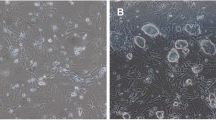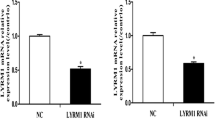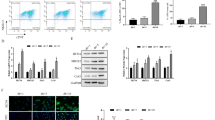Abstract
Uc.40 is a long noncoding RNA that is highly conserved among different species, although its function is unknown. It is highly expressed in abnormal human embryonic heart. We previously reported that overexpression of uc.40 promoted apoptosis and inhibited proliferation of P19 cells, and downregulated PBX1, which was identified as a potential target gene of uc.40. The current study evaluated the effects of uc40-siRNA-44 (siRNA against uc.40) on the differentiation, proliferation, apoptosis, and mitochondrial function in P19 cells, and investigated the relationship between uc.40 and PBX1 in cardiomyocytes. The uc.40 silencing expression was confirmed by quantitative real-time polymerase chain reaction (RT-PCR). Observation of morphological changes in transfected P19 cells during different stages of differentiation revealed that uc40-siRNA-44 increased the number of cardiomyocyes. There was no significant difference in the morphology or time of differentiation between the uc40-siRNA-44 group and the control group. uc40-siRNA-44 significantly promoted proliferation of P19 cells and inhibited serum starvation-induced apoptosis. There was no significant difference in mitochondrial DNA copy number or cellular ATP level between the two groups, and ROS levels were significantly decreased in uc40-siRNA-44-transfected cells. The levels of PBX1 and myocardial markers of differentiation were examined in transfected P19 cells; uc40-siRNA-44 downregulated myocardial markers and upregulated PBX1 expression. These results suggest that uc.40 may play an important role during the differentiation of P19 cells by regulation of PBX1 to promote proliferation and inhibit apoptosis. These studies provide a foundation for further study of uc.40/PBX1 in cardiac development.





Similar content being viewed by others
References
Arrington CB, Dowse BR, Bleyl SB, Bowles NE (2012) Non-synonymous variants in pre-B cell leukemia homeobox (PBX) genes are associated with congenital heart defects. Eur J Med Genet 55:235–237
Bartel DP (2004) MicroRNAs: genomics, biogenesis, mechanism, and function. Cell 116:281–297
Bernard D, Prasanth KV, Tripathi V, Colasse S, Nakamura T, Xuan Z, Zhang MQ, Sedel F, Jourdren L, Coulpier F, Triller A, Spector DL, Bessis A (2010) A long nuclear-retained non-coding RNA regulates synaptogenesis by modulating gene expression. EMBO J 29:3082–3093
Chen H, VanBuren V (2014) A provisional gene regulatory atlas for mouse heart development. PLoS One 9:e83364
Crow MT, Mani K, Nam YJ, Kitsis RN (2004) The mitochondrial death pathway and cardiac myocyte apoptosis. Circ Res 95:957–970
Gendrel AV, Heard E (2014) Noncoding RNAs and epigenetic mechanisms during X-chromosome inactivation. Annu Rev Cell Dev Biol 30:561–580
Han D, Wang M, Ma N, Xu Y, Jiang Y, Gao X (2015) Long noncoding RNAs: novel players in colorectal cancer. Cancer Lett 361:13–21
Harada M, Luo X, Murohara T, Yang B, Dobrev D, Nattel S (2014) MicroRNA regulation and cardiac calcium signaling: role in cardiac disease and therapeutic potential. Circ Res 114:689–705
Hatefi Y (1985) The mitochondrial electron transport and oxidative phosphorylation system. Annu Rev Biochem 54:1015–1069
Holmgren D, Westerlind A, Lundberg PA, Wahlander H (2005) Increased plasma levels of natriuretic peptide type B and A in children with congenital heart defects with left compared with right ventricular volume overload or pressure overload. Clin Physiol Funct Imaging 25:263–269
Hu Y, Lin X, Wang P, Xue YX, Li Z, Liu LB, Yu B, Feng TD, Liu YH (2015) CRM197 in combination with shRNA interference of VCAM-1 displays enhanced inhibitory effects on human glioblastoma cells. J Cell Physiol 230:1713–1728
Ji P, Diederichs S, Wang W, Boing S, Metzger R, Schneider PM, Tidow N, Brandt B, Buerger H, Bulk E, Thomas M, Berdel WE, Serve H, Muller-Tidow C (2003) MALAT-1, a novel noncoding RNA, and thymosin beta4 predict metastasis and survival in early-stage non-small cell lung cancer. Oncogene 22:8031–8041
Leung A, Natarajan R (2014) Noncoding RNAs in vascular disease. Curr Opin Cardiol 29:199–206
Li HJ, Jiang L, Yu ZB, Han SP, Liu XH (2016) Bioinformatic and expression analysis of ventricular septal defect-associated long non-coding RNA TUC40. Zhongguo Yi Xue Ke Xue Yuan Xue Bao 38:1–8
Li H, Jiang L, Yu Z, Han S, Liu X, Li M, Zhu C, Qiao L, Huang L (2017) The role of a novel long noncoding RNA TUC40- in cardiomyocyte induction and maturation in P19 cells. Am J Med Sci 354:608–616
Marino BS, Lipkin PH, Newburger JW, Peacock G, Gerdes M, Gaynor JW, Mussatto KA, Uzark K, Goldberg CS, Johnson WH Jr, Li J, Smith SE, Bellinger DC, Mahle WT (2012) American Heart Association Congenital Heart Defects Committee CoCDitYCoCN and Stroke C. Neurodevelopmental outcomes in children with congenital heart disease: evaluation and management: a scientific statement from the American Heart Association. Circulation 126:1143–1172
Martinou JC, Youle RJ (2011) Mitochondria in apoptosis: Bcl-2 family members and mitochondrial dynamics. Dev Cell 21:92–101
Matsusaka T, Ichikawa I (1997) Biological functions of angiotensin and its receptors. Annu Rev Physiol 59:395–412
Morlando M, Ballarino M, Fatica A, Bozzoni I (2014) The role of long noncoding RNAs in the epigenetic control of gene expression. ChemMedChem 9:505–510
Paffett-Lugassy N, Singh R, Nevis KR, Guner-Ataman B, O'Loughlin E, Jahangiri L, Harvey RP, Burns CG, Burns CE (2013) Heart field origin of great vessel precursors relies on nkx2.5-mediated vasculogenesis. Nat Cell Biol 15:1362–1369
Prall OW, Menon MK, Solloway MJ, Watanabe Y, Zaffran S, Bajolle F, Biben C, McBride JJ, Robertson BR, Chaulet H, Stennard FA, Wise N, Schaft D, Wolstein O, Furtado MB, Shiratori H, Chien KR, Hamada H, Black BL, Saga Y, Robertson EJ, Buckingham ME, Harvey RP (2007) An Nkx2-5/Bmp2/Smad1 negative feedback loop controls heart progenitor specification and proliferation. Cell 128:947–959
Qin P, Haberbusch JM, Soprano KJ, Soprano DR (2004) Retinoic acid regulates the expression of PBX1, PBX2, and PBX3 in P19 cells both transcriptionally and post-translationally. J Cell Biochem 92:147–163
Qin DN, Qian L, Hu DL, Yu ZB, Han SP, Zhu C, Wang X, Hu X (2013) Effects of miR-19b overexpression on proliferation, differentiation, apoptosis and Wnt/beta-catenin signaling pathway in P19 cell model of cardiac differentiation in vitro. Cell Biochem Biophys 66:709–722
Shen Y, Song G, Liu Y, Zhou L, Liu H, Kong X, Sheng Y, Cao K, Qian L (2013) Silencing of FABP3 inhibits proliferation and promotes apoptosis in embryonic carcinoma cells. Cell Biochem Biophys 66:139–146
Song G, Shen Y, Zhu J, Liu H, Liu M, Shen YQ, Zhu S, Kong X, Yu Z, Qian L (2013) Integrated analysis of dysregulated lncRNA expression in fetal cardiac tissues with ventricular septal defect. PLoS One 8:e77492
Srivastava D (2006) Making or breaking the heart: from lineage determination to morphogenesis. Cell 126:1037–1048
Stankunas K, Shang C, Twu KY, Kao SC, Jenkins NA, Copeland NG, Sanyal M, Selleri L, Cleary ML, Chang CP (2008) Pbx/Meis deficiencies demonstrate multigenetic origins of congenital heart disease. Circ Res 103:702–709
Suzuki K, Uchida E, Schober KE, Niehaus A, Rings MD, Lakritz J (2012) Cardiac troponin I in calves with congenital heart disease. J Vet Intern Med 26:1056–1060
Ugarte-Uribe B, Garcia-Saez AJ (2014) Membranes in motion: mitochondrial dynamics and their role in apoptosis. Biol Chem 395:297–311
Wu JX, Adamson ED (1993) Inhibition of differentiation in P19 embryonal carcinoma cells by the expression of vectors encoding truncated or antisense EGF receptor. Dev Biol 159:208–222
Xu H, Morishima M, Wylie JN, Schwartz RJ, Bruneau BG, Lindsay EA, Baldini A (2004) Tbx1 has a dual role in the morphogenesis of the cardiac outflow tract. Development 131:3217–3227
Yang J, Ko SJ, Kim BS, Kim HS, Park S, Hong D, Hong SW, Choi JH, Park CY, Choi SC, Hong SJ, Lim DS (2009) Enhanced cardiomyogenic differentiation of P19 embryonal carcinoma stem cells. Korean Circ J 39:198–204
Acknowledgments
This study was supported by grants from the National Natural Science Foundation of China (grant no. 81470376), the National Natural Science Foundation of Jiangsu Province of China (grant no. BK20141077), Changzhou Municipal Science and Technology Bureau guidance project (grant no. 2016361), and Changzhou Science and Technique Development Foundation (grant no. 20170397).
Author information
Authors and Affiliations
Corresponding authors
Ethics declarations
Conflicts of interest
The authors declare that they have no conflict of interest.
Additional information
Editor: Tetsuji Okamoto
Rights and permissions
About this article
Cite this article
Wu, R., Xue, P., Wan, Y. et al. LncRNA-uc.40 silence promotes P19 embryonic cells differentiation to cardiomyocyte via the PBX1 gene. In Vitro Cell.Dev.Biol.-Animal 54, 600–609 (2018). https://doi.org/10.1007/s11626-018-0284-0
Received:
Accepted:
Published:
Issue Date:
DOI: https://doi.org/10.1007/s11626-018-0284-0




